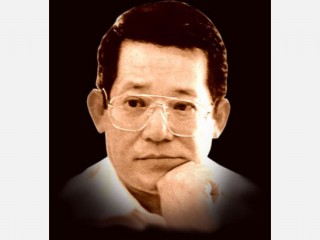
Benigno Aquino biography
Date of birth : 1932-11-27
Date of death : 1983-08-21
Birthplace : Tarlac, Province, Luzon
Nationality : Philippino
Category : Politics
Last modified : 2011-01-12
Credited as : Politician, and Governor of Tarlac,
Benigno Aquino of the Philippines was a leading opponent of the rule of President Ferdinand Marcos. His opposition ended in August 1983 when, after living in exile in the United States for three years, he returned to Manila and was gunned down at the airport. His death precipitated massive demonstrations against President Marcos.
"Nino" Aquino was born in 1933 in Tarlac Province, Luzon, to a prominent family. At age 22 he became the nation's youngest mayor in his hometown of Concepcion. Just six years later he became governor of Tarlac province. In 1967 Aquino once again made history when he became the youngest senator elected in the country's history. Meanwhile he married Corazon Cojoangco; they raised five children.
Aquino became famous for his oratorical gifts and his brilliant mind, as well as his immense ambition. He emerged as the leading candidate for the presidency in 1973 when President Marcos was scheduled to leave office after completing the maximum two terms as president. The Marcos government had already begun its campaign against Aquino, labeling him as a Communist sympathizer because of the contacts he had established with insurgency leaders in central Luzon.
Aquino's ambition to be president was dashed when President Marcos declared martial law and dissolved the constitution. Marcos took all power unto himself and jailed his political opponents, including Aquino. Aquino spent over seven years in prison and was found guilty of murder, subversion, and illegal possession of firearms. Aquino denied these charges as well as the legitimacy of his trial and conviction by a military tribunal. In 1980 he was allowed to go to the United States for a heart bypass operation, and he remained in exile as a research fellow at Harvard University until his ill-fated return in 1983.
Following the assassination, and after appointing his own investigative commission of cronies, President Marcos was pressured to appoint a five-person non-partisan investigative board led by Judge Corazon Agrava. Marcos and the military stated that the assassination was carried out by a lone gunman in the pay of the Communist Party. The alleged gunman, Rolando Galman, was shot at the airport immediately following the shooting of Aquino, so he could not be cross-examined. The military carried out its own investigation and reported, not surprisingly, that no military personnel were involved in the death.
The official commission's majority report found that Aquino was not slain by the alleged Communist hireling as claimed by Marcos and the military but was the victim of a "criminal conspiracy" led by the military and including Gen. Fabian Ver, the armed forces chief of staff, the highest ranking general of the country, and a close friend and cousin of President Marcos. Ver's indictment included complicity in attempting to cover up the crime.
The commission's findings were astonishing, although from the beginning most Filipinos doubted the official version of the assassination. Almost no one believed that military generals would order the execution of Aquino on their own initiative, although no proof was ever presented that directly implicated the president. It is true that Aquino posed a threat as a possible unifier of the dispersed opposition. He had been the president's principal adversary for decades.
Ironically, the democratic opposition to Marcos was strongest after it lost its most famous leader. In death Aquino became more powerful than ever. The assassin of Aquino could never have known how seriously the authority of President Marcos would be undermined by his act. As Marcos lost credibility, the economy of the Philippines deteriorated so that by 1985 the nation was in political and economic chaos. At the same time, the opposition used the assassination to its own advantage so that Marcos was forced to relent on many of his most onerous policies. The press began publishing critical commentary and the elections for the National Assembly resulted in a dramatic increase in the number of oppositionists elected.
In December 1985 the court exonerated General Ver and the others charged with Aquino's murder. Marcos promptly reinstated Ver to his former position. But popular unrest with Marcos' rule was growing steadily and within weeks would coalese around Aquino's widow, Corazon.
A biography of the Aquino family written by Nick Joaquin is The Aquinos of Tarlac: An Essay on History as Three Generations (Manila, 1983). Other sources include Gerald N. Hill and Kathleen Thompson Hill, Aquino Assassinated: The Story and Analysis of the Assassination of Philippine Senator Benigno S. Aquino (1983) and National Library of Australia, Benigno Aquino: A Select Bibliography of Articles in Periodical Publications Held in the National Library of Australia (Canberra, 1983). For detailed analysis of the assassination, see the weekly issues of Asia Week and Far Eastern Economic Review beginning August 21, 1983.
Aquino, Benigno S., Testament from a prison cell, Makati, Metro Manila, Philippines: Benigno S. Aquino, Jr. Foundation, 1984.
Benigno, Teodoro C., Ninoy, the heart and the soul, Manila: Office of the Press Secretary, Bureau of Communications Services, 1988.
Hill, Gerald N., Aquino assassination: the true story and analysis of the assassination of Philippine Senator Benigno S. Aquino, Jr., Sonoma, Calif.: Hilltop Pub. Co., 1983.
Joaquin, Nick., Ninoy Aquino in the Senate: final chapters of The Aquinos of Tarlac: an essay on history as three generation, Mandaluyong, Metro Manila: Solar Pub. Corp., 1986.
Ninoy Aquino: the man, the legend, Metro Manila, Philippines: Cacho Hermanos, 1984.
Policarpio, Alfonso P., Ninoy: the willing martyr, Philippines: Isaiah Books, 1986.
White, Mel, Aquino, Dallas: Word Pub., 1989.
















